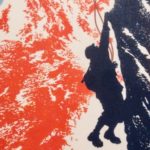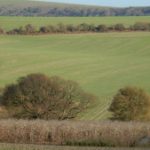About › Forums › Den of Writers › Blogs › Film, storytelling – psychic distance again – and looking under the bonnet
Tagged: film & psychic distance
- This topic has 8 replies, 4 voices, and was last updated 1 year, 8 months ago by
 Sandra.
Sandra.
-
AuthorPosts
-
July 14, 2022 at 12:54 pm #12416
 DaedalusParticipant
DaedalusParticipantThis is going to be a super quick and probably slightly rambling blog but it’s been in my mind for a little while and I find the subject interesting so I’m just going to throw it down and see if anyone can relate.
I’ve been thinking a lot about films lately – very specifically, the way shots are composed, and what this might tell us about storytelling, and possibly if it has any relevance for writing. Film and prose fiction seem to be two media divided by a sort-of common language, and while there is a lot of similarity in story structure etc (we often use films as examples to demonstrate three or five act structure) but can this translate down to the level of scenes and shots?
What prompted this was the film Midsommar. It’s a relatively recent horror film that both plays with and rejects many of the conventions of that genre, but what particularly caught my attention was the way it was shot. I became aware during the film that it was not shot in the way most films are. I couldn’t particularly pinpoint how it was different to more conventional films – I found I was so inured to the conventional approach that I was effectively blind to it. In particular, several scenes consisted of a single, wide shot. Rather than the camera following the characters, characters moved in and out of a fixed frame. Or perhaps the camera might move along different sets of characters, each one involved in their own ‘scene’. In a few cases, there is an immense amount going on in the background telling its own story or part of a wider story, but which we might not even notice as we concentrate on the characters in the foreground.
I started researching the way films are generally shot, and it led me down an interesting (to me, anyway) rabbit hole. It seems to me that the typical portfolio of shots that a director uses exist because of the unique combinations of limitations and freedoms of cinema in its early heyday. I am by no means a student of film so all this might be total rubbish but here goes.
Very early filmmakers like the Lumière brothers were partly making it up as they went, but also faced extreme limitations in terms of the technology so they had to be creative in order to tell the story. By the time of the early talkies, the technology had improved to allow cameras to move around, zoom in and out, and so on, and this established the common series of shots. A digression – one of the first times I really noticed a stylistic choice in shot was the moment in 2001: A Space Odyssey just before HAL 9000 murders Frank Poole. We see HAL’s red ‘eye’, the shot cutting quickly closer and then even closer, in silence. It doesn’t zoom, it moves in steps so distinct they might be accompanied by drum beats. (It’s known as a Staggered Zoom, or Three Cut Zoom). The camera then cuts to the EVA pod menacingly approaching the unwitting Poole, and then his spacesuited body tumbling away into space, oxygen tube flapping uselessly. It was only a few years later that I realised that Kubrick had borrowed this shot from James Whale’s Frankenstein. Whale did it because he had to – there was no way to physically zoom in as quickly as he wanted to. So he did it in three shots. Bam, bam, bam. And that staggered zoom is far more powerful than a smooth zoom would have been. So much so that filmmakers continued using it even when the technology allowed them to quickly zoom right in to a character’s face from a wide shot.
Interestingly, or perhaps unsurprisingly, the categories of shots are mostly structured around people – how close-up or wide the framing of them is, and how many are in the frame. Examples of the former go from Extreme Wide Shot to Extreme Close Up, and examples of the latter are basically termed One-Shot, Two Shot etc depending on how many people are prominent in the shot and a roughly similar distance from the camera. The most common shot in cinema is the Medium Shot – this is a shot of a character or characters from the waist up. (There is a variation called the ‘Cowboy Shot’ which extends slightly down to the hips, where it can show the holster of a cowboy – hence the name). We can then move in, to the Medium Close-Up (showing the shoulders and head), Close-up (just the head) and Extreme Close-Up (a portion of the head) or out, to the Full Shot (framing the character’s full length) and then to Wide or Extreme Wide shots, where the character becomes less important than the setting, or even overwhelmed by it. (The Extreme Wide Shot apparently became popular with Westerns, and is something of a rarity in films before the 40s).
And what does this most obviously correspond to in writing? It will no doubt be familiar to any graduate of the Self Edit course as Psychic Distance – the tool to express how far we are inside a character’s head at any given time during the narrative. The typical level of PD, level 3, corresponds to the Medium Shot. It gives us a good balance of seeing the character in some detail while also showing a bit of the scenery around them. Closer in, we see more of the character’s responses and less of what they are responding to. Further out, and we see more of what’s around them and less of the character themselves.
So I think what I was reacting to with Midsommar was that the director, Ari Aster, was finding ways to put us closely within characters’ heads while staying ‘wide’. He was helped by technology in doing this – Midsommar used some extremely high definition cameras that enabled excellent detail to be captured even at a greater distance. There are perhaps analogues. Writers like James Salter have the knack of defying the Psychic Distance scale by conveying a character’s innermost thinkage in a very detached style, with the slightest gesture or observation putting us right there. I’m sure there’s a lot more to it than this, but I found it an interesting thought process. I’ve done a lot of looking under the bonnet of writing (I dare say most of you are like me in that you never quite read anything in the same way as before you became a writer, there’s always some focus on the technique even as you’re swept along by the story) but relatively little with film until now. And it has been really eye-opening in terms of how stories are told, how we might be limiting ourselves unwittingly through the conventional structures that have built up to help us describe the processes of writing, and how we can learn from different media.
Would love to hear your takes (no pun intended) on this.
July 14, 2022 at 6:53 pm #12419 DaedalusParticipant
DaedalusParticipantI was going to edit this to add some links but apparently I’m too late. Anyway, in case there are any non-SE grads out there, some details on psychic distance here
July 15, 2022 at 7:46 am #12422 LibbyParticipant
LibbyParticipantMany thanks for this, Daeds. You sum up very well my feeling about prose vs film: “Film and prose fiction seem to be two media divided by a sort-of common language.” It’s the seem and sort-of which interest me.
“So I think what I was reacting to with Midsommar was that the director, Ari Aster, was finding ways to put us closely within characters’ heads while staying ‘wide’.” This aligns with my thoughts about seeing a correlation between the psychic distance slide and the camera zoom or staggered zoom (thanks for explaining that – I didn’t know about the SZ).
The following may be illogical and mistaken. I don’t watch many movies these days.
I think a correlation doesn’t always exist. To me that’s good news; they’re different art forms and the point is that that they’re, well, different. I just fear it when other commentators on writing use camera shots as examples as if it’s the best, even the only way, to think about psychic distance. A novice writer could have their imagination limited, especially at the far ends of the PD scale of omniscient narration and stream of consciousness. Could any long shot be able to capture something as wide as the opening of Dickens’ Bleak House: “Fog on the Essex marshes, fog on the Kentish heights.” Maybe it could — I don’t know much about film techniques. At the scale’s other end it seems to be the skills of the actor in conjunction with the camera operative and director which show thought. Close-ups help, but I’m not sure they’re necessary. A character can look confused, panicked, euphoric or whatever and show a series of reactions in a shot that includes, say, another character on either side of them.
The cowboy shot is interesting for being able to show what the cowboy sees, assuming the shot is from behind him, at the same time as a scene-encompassing view for the audience. I’m sure there are examples from non Westerns but I can’t think of any at present. In that case I do see a correlation with level 3 on the psychic distance scale, “Henry hated snowstorms” in John Gardner’s example, putting the reading in both the narrator’s and the character’s point of view, or either of their POVs depending on how we want to see the scene. Or we’re sliding from one to the other.
I like you drawing attention to how the camera POV can be fixed while the characters move in and out of shot. To me it can be very atmospheric, showing the way a house, for example, is a character itself while the human characters move through it and use it in different ways. As you say, it is, “telling its own story or part of a wider story, but which we might not even notice as we concentrate on the characters in the foreground.”
I’m glad you reminded me about James Salter. I hope I’ve remembered this right but I think it’s in Light Years where the narrator comments on the Hudson River that the river is self-cleaning. It’s not of course, but at the time — the 1970s? — rivers were often complacently seen this way, a reason not to do anything about them. If I read it properly, it summed up the character’s thought at that moment, his approach to life in general and the approach of a whole society. There was a panoramic view of attitudes all in one phrase. Of course all this be achieved in film but I think it would need dialogue or foregrounding or something, in addition to views of the river, to present the information so neatly.
Or maybe Light Years has been filmed brilliantly. But thanks for raising the questions about cameras vs words.
July 15, 2022 at 3:00 pm #12430 WoolleybeansParticipant
WoolleybeansParticipantI find it interesting how different people absorb PD in different ways.
I feel two aspects, at least, were being discussed on the Self-Edit course.
The actual physical distance of the description, which would correlate more to the wide or medium or close shot, seemed to be part of it. It certainly turned up in examples. It did not, however, seem to me to be the defining factor of PD, or at least not the bit which struck me as a new aspect to consider.
For me, that aspect was/is the level to which the POV character’s thoughts, feelings etc influence/become part of the writing style itself.
As for how that correlates to film/TV…
The saturation of colours? Whether the shot angles up through something? The somewhat cliché blurry/wobbly scene?
If nothing else, I think it’s useful to remind ourselves they are different medium, because it can be easy to fall into imagining a prose piece should deliver a series of scenes in the way a standard TV show or film does, whereas actually each medium has a lot of stuff it can play with that doesn’t fall into that.
I have yet to work out how soundtracks can be in a novel, for instance, unless you put together a playlist. Which, in fanfic, people do sometimes. I have seen it, though rarely: a list of links of which songs to listen to as you read. Can’t say I’ve ever clicked those links, but still.
And in prose, to have the level of detail – including a lot going on in the background – may have something of a different impact than the scenes you describe in the film, Daeds. Easier to slip some things in mostly unnoticed when a whole background can be seen in a glance, I expect.
I very much doubt it would have the same impact should someone try to describe every single detail of a scene in a novel.
I have no coherent thought, here. But then, that’s pretty normal these days.
I guess…yeah, I think the limitations/opportunities of each medium do affect what is created. I do think there are correlations, but don’t think there is a complete one-for-one correlation across the board. I don’t think we need there to be that one-for-one correlation.
I am now wondering how ‘advances in technology’ could be said to have altered prose fiction. People could write down something has a colour without having to wait for colour printers, after all.
July 16, 2022 at 3:24 pm #12435 DaedalusParticipant
DaedalusParticipant@woolleybeans wrote: “For me, that aspect [the defining factor of PD] was/is the level to which the POV character’s thoughts, feelings etc influence/become part of the writing style itself.
As for how that correlates to film/TV…
The saturation of colours? Whether the shot angles up through something? The somewhat cliché blurry/wobbly scene?”
I absolutely agree with this take on PD, but I think filmmakers, conventionally at least, are often trying to get close to this with the extent to which a shot closes in to a character. E.g. as the emotion and/or tension heightens, the camera moves closer in. A nice example of this is in Hitchcock’s ‘Rope’ during a sequence where during a dinner party James Stewart suspects one of the other characters of foul play and starts asking difficult questions. It starts out at a Medium Shot, then the camera is ‘distracted’ by something and moves away from the two characters briefly. When it moves back, it’s in a Medium Close-Up. Most people wouldn’t notice the difference consciously, but it would lend a sense of increasing discomfort, especially as we the audience are complicit to a degree. It strikes me that the Extreme Close-Up is most often used to convey the character’s emotional state more than anything else, being able to capture tiny facial movements, eyes widening or narrowing, breathing, sweat, tears, muscle tension and so on.
There are certainly other ways to contribute to the character’s thoughts/feelings being emphasised on film. Colour, stability, focus as you say. Other things like ‘Dutch Angles’ (shooting on a tilt), high or low angle (Orson Welles famously dug holes in the floor of the sound stage while filming Citizen Kane so he could get the lens down to floor level, looking up at the characters like they were giants), lighting, sound design, music or lack of it. You might get Close-Up ‘Insert Shots’ of something other than the character’s face, say, their hand tightening on a gun, or a glass so tightly they break it and draw blood (another example from Rope).
Really interesting point about technology. I had been giving some thought to that, and wondered if we could consider concepts like PD as analogous to technology. After all, people before Gardner were more or less instinctively doing something akin to it, but as soon as Gardner codified it, he reified it and allowed people to develop it as a technique, exploiting its potential in a way that would not have been possible without identifyng it. Perhaps it would be like the way James Joyce used language, and certain aspects of it were then assimilated and absorbed into mainstream style.
July 20, 2022 at 8:00 am #12443 LibbyParticipant
LibbyParticipantHmm, essay alert — me pontificating. I think Modernists such as James Joyce and Virginia Woolf had an excellent grasp on the categories of psychic distance, although they probably didn’t call it that, going instead for stream of consciousness, free indirect style and omniscience. They announced themselves to be influenced by cinema and used it to alter how they portrayed the world in a more chopped-up style. The Victorians also wrote intense locked-in emotion and characters’ wobbly uncertainty about their own perceptions, though – generalisation here – did they tend to use first person rather than third to do it? Their accretion of detail and metaphor to build scenes and emotion can be seen as distant these days, especially if the metaphors are now hard to understand, though I don’t think the best writers can be accused of remoteness. They were keen on handling the differences between close and distant narration.
August 8, 2022 at 6:50 pm #12536 DaedalusParticipant
DaedalusParticipantSorry for delay in replying to your very interesting thoughts @libby, but I’ve been neck deep in work lately.
Re modernists etc using the techniques and ideas of psychic distance before Gardner codified it. Yes, absolutely, a large measure of what he was doing was identifying techniques that were already out there. I would suggest that his innovation was in aggregating those existing techniques, and most importantly in arranging them as a continuum, which (correct me if I’m wrong) had not been done before. And I think because of that, we now think about the whole business differently. But it’s very much a subjective view.
A few floaty and unconsidered thoughts. Re-watched Michael Mann’s ‘Heat’ recently and the difference between the performance of both leads is striking (Al Pacino’s is very scenery-chewing, over the top, Robert de Niro’s is much more subtle, naturalistic and reserved – he pretty much only raises his voice when he’s robbing a bank) but I also wondered if this led to a difference in the way Michael Mann shot their scenes. I haven’t checked it at all but it feels as though de Niro has more extreme close-ups, especially in his more pivotal scenes, as he can convey an incredible amount of inner ‘life’ through the subtlest modulations of expression. Pacino has more medium close-ups (particularly in the famous ‘great ass’ scene) partly I suspect because we don’t need to be right up close to see his eyes bulging and veins standing out, partly because it becomes as interesting to see the reactions of characters around him, and partly because it would just be too intense for the audience. I don’t think I can think of a parallel in prose fiction. And it also suggests another difference between the two media, in that the screen has to choose which level of ‘closeness’ for each shot whereas in prose I think we can be more flexible in the moment. That said, a study of some great scenes at a really detailed level shows just how much is being communicated to the audience, most of which is not consciously appreciated, and it’s perhaps harder for us as writers to subtly place things in the background the way visual arts can.
It’s all just a thought experiment anyway, but it’s fun pulling on these threads and seeing where they lead.
August 22, 2022 at 8:19 am #12608 LibbyParticipant
LibbyParticipantHi @Daedalus
Thanks for taking time out to answer my thoughts.
I hadn’t thought of it that way before, that film/video is better at placing significant information in the background of shots. That’s something that can be difficult in writing — at least I find it difficult — and often requires a setting to be introduced earlier than the action. Obviously film does that too but the written version seems especially analog but also more rationed in order to keep the story moving.
I haven’t seen Heat but will look for some clips.
The whole business of psychic distance is interesting, particularly readers’ and viewers’ varying perceptions of it and their different needs as to what makes a narrative come alive.
PS No need to reply to this unless you want to!
August 29, 2022 at 7:59 am #12659 SandraParticipant
SandraParticipantJust come across this while procrastinating and would firstly say I found it fascinating. I know I lack analytical skills and rarely watch films, finding them lacking compared to books, so your post, Daeds, and subsequent comments, have opened my eyes to a new way of viewing – I’ll come back and re-read several times more – so thank you.
-
AuthorPosts
- You must be logged in to reply to this topic.
